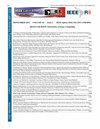Compact Ultra-Wide-Stopband Microwave Bandpass Filter with Multiple Transmission Zeros by Integrating an L-Shaped Bandpass Filter and a Stepped Impedance Lowpass Filter
IF 1.3
4区 工程技术
Q3 COMPUTER SCIENCE, INFORMATION SYSTEMS
引用次数: 0
Abstract
A compact ultra-wide-stopband microwave bandpass filter is introduced in this work using an L-shaped quarter-wavelength resonator and stepped impedance resonators. The bandpass filter (BPF-I) is designed at 2.1 GHz (f) using an L-shaped quarter-wavelength line. The lowpass filter is developed at 4 GHz using stepped impedance resonators. The introduced ultra-wide-stopband filter is created through integrating the BPF-I and the lowpass filter. Filter size reduction is achieved through the L-shaped quarter-wavelength line, while the ultra-wide-stopband is attained through the stepped impedance resonators. The mathematical analysis of the introduced ultra-wide-stopband bandpass filter is conducted through the extraction of ABCD and S-parameters. The lumped elements equivalent circuits are realized for the introduced filter, and their S-parameters are plotted. The introduced filter is fabricated on an FR4 substrate, and its S-parameters are measured. The comparison of mathematical analysis, EM simulated, circuit simulated, and measured results, showing good agreement. Measurements show a 140.4% fractional bandwidth (FBW), better than 20 dB return loss, higher than 28 dB rejection up to 30 GHz (14.3f) in the out-of-band with many transmission zeros, and 0.8 dB insertion loss. 0.23g x 0.37g is the overall dimension of the introduced filter.集成l型带通滤波器和阶跃阻抗低通滤波器的紧凑超宽阻带微波带通滤波器
采用l型四分之一波长谐振器和阶跃阻抗谐振器设计了一种紧凑的超宽阻带微波带通滤波器。带通滤波器(BPF-I)采用l型四分之一波长线设计为2.1 GHz (f)。低通滤波器是在4 GHz使用阶跃阻抗谐振器开发的。所介绍的超宽阻带滤波器是通过集成BPF-I和低通滤波器创建的。通过l型四分之一波长线实现滤波器尺寸减小,而通过阶跃阻抗谐振器实现超宽阻带。通过ABCD和s参数的提取,对所引入的超宽阻带带通滤波器进行了数学分析。对所引入的滤波器实现了集总元件等效电路,并绘制了其s参数。在FR4衬底上制作了该滤波器,并对其s参数进行了测量。数学分析、电磁仿真、电路仿真与实测结果进行了比较,结果吻合较好。测量结果表明,该系统的分数带宽(FBW)为140.4%,回波损耗优于20db,在具有多个传输零的带外(14.3f)频率下高于28db抑制,插入损耗为0.8 dB。0.23g x 0.37g为所引入滤波器的整体尺寸。
本文章由计算机程序翻译,如有差异,请以英文原文为准。
求助全文
约1分钟内获得全文
求助全文
来源期刊

IEEE Latin America Transactions
COMPUTER SCIENCE, INFORMATION SYSTEMS-ENGINEERING, ELECTRICAL & ELECTRONIC
CiteScore
3.50
自引率
7.70%
发文量
192
审稿时长
3-8 weeks
期刊介绍:
IEEE Latin America Transactions (IEEE LATAM) is an interdisciplinary journal focused on the dissemination of original and quality research papers / review articles in Spanish and Portuguese of emerging topics in three main areas: Computing, Electric Energy and Electronics. Some of the sub-areas of the journal are, but not limited to: Automatic control, communications, instrumentation, artificial intelligence, power and industrial electronics, fault diagnosis and detection, transportation electrification, internet of things, electrical machines, circuits and systems, biomedicine and biomedical / haptic applications, secure communications, robotics, sensors and actuators, computer networks, smart grids, among others.
 求助内容:
求助内容: 应助结果提醒方式:
应助结果提醒方式:


